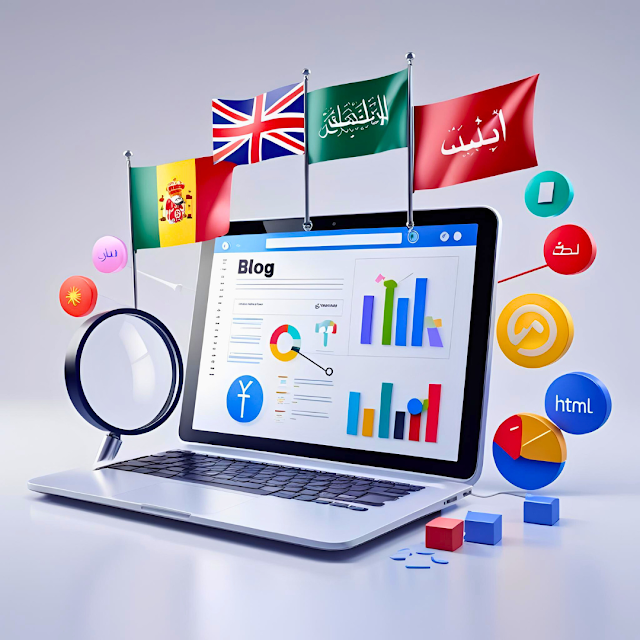SEO Optimization for Multi lingual website in 2025 Guide
Why does a multi lingual website need special SEO?
In this article, and through the Larache Tech Blog, we will explore why we are now in a world characterized by digital globalization, and why having a multilingual blog has become essential to attracting a global audience. However, simply publishing translated content is not enough to achieve a top ranking in search results.
Main challenges:
- Competition for keywords varies between languages.
- Google treats each language as a separate site.
- It is necessary to use hreflang tags to avoid duplicate content.
- User experience varies by region and language.
Source: Google Translate Guide
Choosing the optimal structure for a multi lingual URL
Link structure is one of the most important factors in multilingual SEO. There are three main ways to organize URLs:
a) Subdomains
Example: ar.example.com(Arabic)
Features:
- clear separation between languages
- Specific countries can be targeted via Google Search Console.
Disadvantages:
- It may take more effort to build domain authority.
b) Subdirectories
Example:example.com/ar/
Features:
- Maintains the strength of the main band
- Easier to manage and implement
Disadvantages:
- Less accurate in targeting specific areas
Expert Tip for 2025: Subdirectories ( ) are recommended example.com/ar/if the focus is on improving SEO with ease of maintenance. For larger sites, subdomains ( ar.example.com) can be used to aggressively target specific countries.
Source: Moz's Multilingual SEO Guide
hreflang tags: the key to avoiding duplicate content
hreflang tags tell Google that you have content translated or adapted for different languages.
How to apply hreflang correctly?
a) Using <link> elements in HTML
<link rel="alternate" hreflang="ar" href="https://example.com/ar/" />
<link rel="alternate" hreflang="en" href="https://example.com/" />
<link rel="alternate" hreflang="x-default" href="https://example.com/" />b) Add it to the sitemap (Sitemap XML)
<url>
<loc>https://example.com/ar/</loc>
<xhtml:link rel="alternate" hreflang="en" href="https://example.com/" />
<xhtml:link rel="alternate" hreflang="ar" href="https://example.com/ar/" />
</url>Common mistakes to avoid:
- Incorrect language codes (such as using arabic
sainstead ofararabic) - Forgetting to include a link back (each page should point to the other)
Use the hreflang generator to validate your application.
How to Optimize Content for Each Language (Don't Rely on Machine Translation!)
Literal translation via Google Translate results in poor and SEO-intensive content.
a) Targeting the right keywords for each language
- Use tools like Google Keyword Planner or Ahrefs.
- Example: The word "smartphone" in Arabic may differ from "smartphone" in English.
b) Adapting content to local culture
Some phrases or examples may not be appropriate for all cultures. Images and videos should reflect the cultural diversity of the target audience.
c) On-Page SEO Optimization for Each Page
- Titles and Meta Descriptions should be unique and optimized for each language.
- Use subheadings (H2, H3) logically.
- Internal links must point to pages in the same language.
Read more about On-Page SEO from Backlinko.
Improving speed and performance for users around the world
Site speed is an important ranking factor, especially for multilingual websites.
Tips to improve performance:
- Use a CDN like Cloudflare
- Reduce image size with tools like TinyPNG
- Use WebP format for images
- Enable caching of static content
Test your site speed with Google PageSpeed Insights .
Monitoring and continuous improvement
SEO optimization is an ongoing process. Use these tools to monitor your performance:
- Google Search Console : For error tracking and indexing
- Google Analytics 4 : To analyze visitor traffic
- SEMrush or Ahrefs : To monitor rankings
The most important implementation steps to improve the SEO of a Multi lingual web or blog
- Choose the appropriate URL structure (
/ar/preferablyar.example.com) - Apply hreflang tags to avoid duplicate content.
- Create original, optimized content for every language.
- Improve site speed with CDN and image compression
- Continuously monitor performance through analytics tools.
🚀 Get started today and get your site search-ready in 2025!
Share your experience with multilingual SEO in the comments below.
